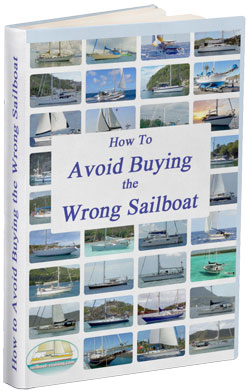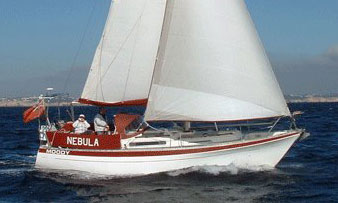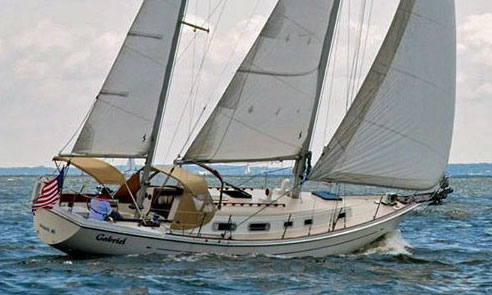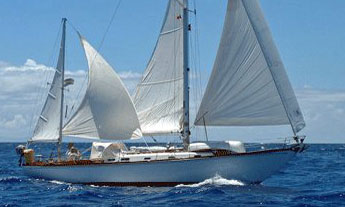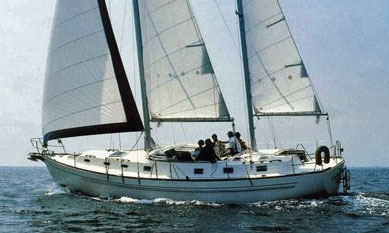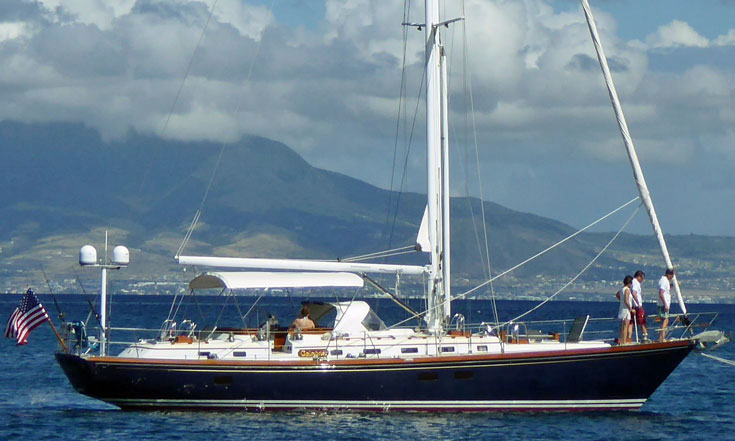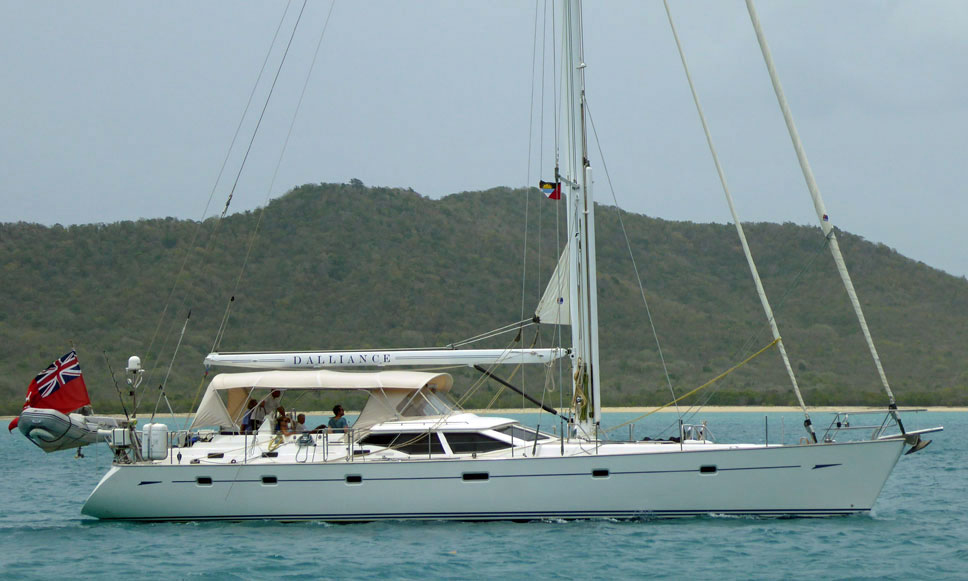- Home
- Cruising Yachts 35' to 40'
- Bowman 36
The Bowman 36 Sailboat
The Bowman 36 sailboat was designed by Holman & Pye and manufactured by E.V. Offshore / Bowman Yachts in the United Kingdom throughout the years 1971 to 1987.
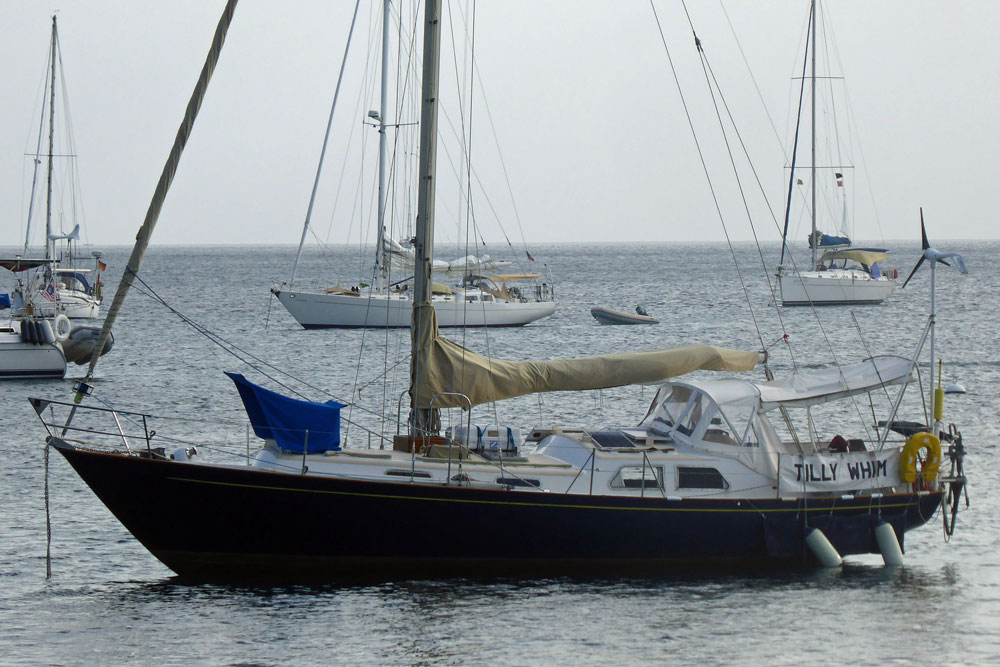 A Bowman 36 sloop.
A Bowman 36 sloop.Published Specification for the Bowman 36
- Keel & Rudder Configuration: Long keel with a protected rudder.
- Hull Material: GRP (Fiberglass).
- Length Overall*: 10.97 metres (36'0").
- Waterline Length*: 8.53 metres (28'0").
- Beam*: 3.43 metres (11'3").
- Draft*: 1.68 metres (5'6").
- Rig Type: Masthead Sloop or Masthead Cutter.
- Displacement*: 7,121 kg (15,700 lbs).
- Ballast*: 3,175 kg (7,000 lbs).
- Sail Area*: 60.39 m² (650 ft²).
- Water Tank Capacity: Approximately 364 litres (80 Imperial gallons).
- Fuel Tank Capacity: Approximately 227 litres (50 Imperial gallons).
- Hull Speed: Approximately 7.1 knots
- Designer: Holman & Pye.
- Builder: E.V. Offshore / Bowman Yachts.
- Year First Built: 1971
- Year Last Built: 1987
- Number Built: Approximately 100.
* Used to derive the design ratios referred to later in this article - here's how they're calculated...
Design Options & Alternatives
The Bowman 36 was primarily offered as a masthead sloop. However, a masthead cutter rig was also a common option. There is no indication of fractional sloop or ketch options for the standard Bowman 36.
The Bowman 40 (introduced 1975): Designed by Laurent Giles, this was a stretched version of the Bowman 36 hull, meaning it shared the same fundamental design but with added length. This would have typically resulted in increased interior volume, potentially more deck space, and likely improved performance in certain conditions due to a longer waterline.
Note: This version should not be confused with the later Chuck Paine-designed Bowman 40.
Bowman 46 (later models): Later, the Bowman range also included the Bowman 46, which was a distinct design but carried forward the reputation for well-built, capable offshore cruisers established by models like the Bowman 36 and 40.
Sail Areas & Rig Dimensions
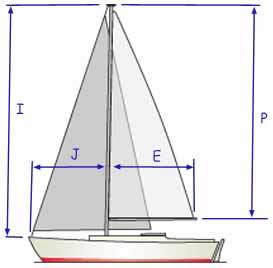 Sail Areas & Rig Dimensions
Sail Areas & Rig DimensionsSail Areas
- Mainsail Area: 25.55 m² (275 ft²).
- 100% Foretriangle Area: 34.84 m² (375 ft²).
Rig Dimensions
- I (foretriangle height): 14.17 metres (46'6").
- J (foretriangle base): 4.98 metres (16'4").
- P (main luff): 12.04 metres (39'6").
- E (main foot): 4.27 metres (14'0").
Published Design Ratios
The Key Performance Indicators (KPIs)
The key design ratios for the Bowman 36 are:
- Sail Area/Displacement Ratio (SA/D): 16.48.
- Displacement/Length Ratio (D/L): 365.17.
- Ballast/Displacement Ratio (B/D): 44.60%.
- Comfort Ratio: 35.13.
- Capsize Ratio: 1.76.
Theoretical Sailing Characteristics
These design ratios offer insights into the Bowman 36's theoretical sailing performance:
- Sail Area/Displacement Ratio (SA/D) - 16.48: An SA/D ratio of 16.48 suggests that the Bowman 36 is a moderately powered sailboat. Yachts with SA/D ratios in this range are generally considered to be adequate performers in light to moderate winds, but they are not typically designed for high-performance racing. They can make good progress in various conditions without being overly sensitive to gusts or requiring constant sail changes.
- Displacement/Length Ratio (D/L) - 365.17: A D/L ratio of 365.17 places the Bowman 36 firmly in the "heavy displacement" category. This indicates a robustly built yacht with significant internal volume and structural integrity. Heavy displacement boats are known for their comfortable motion in a seaway, their ability to carry substantial stores for extended cruising, and their inherent stability. They tend to be slower to accelerate and reach hull speed compared to lighter boats, but they maintain their speed well in choppy conditions and are less affected by adverse seas.
- Ballast/Displacement Ratio (B/D) - 44.60%: A B/D ratio of 44.60% is quite high, indicating a significant amount of ballast relative to the boat's overall displacement. This high ballast ratio contributes significantly to the boat's initial stability and its ability to resist heeling. It suggests a stiff boat that can carry its canvas well in stronger winds, providing a more comfortable and reassuring motion for offshore passages. This also implies good recovery from knockdowns.
- Comfort Ratio - 35.13: A Comfort Ratio of 35.13 is on the higher side, supporting the expectation of a comfortable ride, especially in rougher conditions. The Comfort Ratio aims to quantify a boat's motion at sea, with higher numbers indicating a more comfortable motion due to factors like heavier displacement and fuller ends that resist pitching. This suggests the Bowman 36 would be well-suited for extended cruising and offshore passages where comfort for the crew is paramount.
- Capsize Ratio - 1.76: A Capsize Ratio of 1.76 is very good, well below the generally accepted threshold of 2.0 for offshore cruising boats. A lower capsize ratio indicates a boat that is less prone to capsizing in rough seas. This ratio considers beam, displacement, and ballast, and a value like 1.76 speaks to the Bowman 36's inherent stability and suitability for offshore work, providing a high degree of safety and seaworthiness.
In summary, the design ratios suggest that the Bowman 36 is a well-built, stable, and comfortable offshore cruising yacht. While not a speed demon, its heavy displacement, high ballast ratio, and favourable capsize ratio point to a boat that handles rough weather well, provides a comfortable motion, and inspires confidence for long voyages. Its moderate sail area is in keeping with a cruiser that prioritises ease of handling and stability over raw performance.
But the Design Ratios Don't Tell the Whole Story...
While design ratios offer a convenient and quick way to get a theoretical understanding of a sailboat's characteristics, they have several significant limitations:
- Simplification of Complex Hydrodynamics: Design ratios are based on simplified mathematical formulae that use only a few key dimensions (length, beam, displacement, sail area, ballast). They cannot capture the intricate hydrodynamic interactions between the hull, keel, rudder, and sails in real-world conditions. Factors like keel and rudder profiles, wetted surface area, hull shape (e.g., U-shaped vs. V-shaped sections, entry, and exit angles), and appendage design significantly impact performance, manoeuvrability, and seakeeping, but are not directly accounted for in these ratios.
- Ignores Rig and Sail Plan Nuances: Ratios like SA/D use total sail area, but they don't differentiate between masthead or fractional rigs, aspect ratios of sails, or the efficiency of different sail plans (e.g., cutter vs. sloop). The centre of effort of the sail plan relative to the centre of lateral resistance of the hull, which is crucial for balance and weather helm, is not considered.
- Static vs. Dynamic Conditions: Design ratios represent static snapshots. They don't account for how a boat performs dynamically in varying wind strengths, wave conditions, or different points of sail. For example, a high ballast ratio indicates good initial stability, but it doesn't tell you about the boat's ultimate stability curve or its behaviour in a breaking wave.
- Crew Skill and Trim: The actual sailing performance of any boat is heavily influenced by the skill of the crew, how well the sails are trimmed, and how the boat is loaded. Ratios provide an inherent characteristic, but not a guarantee of performance in practice.
- Subjectivity of "Comfort": While the Comfort Ratio attempts to quantify motion, comfort is inherently subjective. What one person finds comfortable, another might not. Furthermore, the Comfort Ratio is a single number and doesn't detail specific motion characteristics like pitch, roll, or yaw, or how quickly these motions dampen.
- Lack of Context for Modern Designs: Some ratios were developed in an era when design principles were different. Modern designs with advanced hull forms, bulb keels, or high-aspect ratio foils may not be accurately characterised by traditional ratios. For instance, a lightweight, wide-sterned modern cruiser might have a high D/L but perform very differently from a traditional heavy displacement boat.
- Does Not Account for Construction Quality and Condition: Ratios say nothing about the build quality, structural integrity, or the condition of an aging vessel. A well-designed boat with poor construction or significant wear and tear will perform worse than its ratios might suggest.
- Omission of Practicality and Livability: Ratios are purely performance or motion-oriented. They do not convey anything about interior volume, headroom, storage, deck layout, ease of handling, maintenance requirements, or overall suitability for a specific type of cruising or living aboard, all of which are crucial "characteristics" for a sailboat owner.
In conclusion, while design ratios serve as useful initial indicators for comparing sailboats and understanding their general theoretical tendencies, they should always be interpreted as part of a much larger picture. They provide a quantitative starting point but must be supplemented with a deeper understanding of naval architecture, real-world performance reviews, and ideally, personal experience with similar vessels to truly define a sailboat's characteristics.
More Specs & Key Performance Indicators for Popular Cruising Boats
Recent Articles
-
Planning Your Sailboat Liveaboard Lifestyle: An Ocean Sailor's Guide
Dec 06, 25 05:18 AM
Seasoned sailors share their methodical risk analysis for planning a secure Sailboat Liveaboard Lifestyle, covering financial, property, and relationship risks. -
Marine Cabin Heaters: The Expert’s Guide to Comfort & Safety at Sea
Dec 05, 25 06:52 AM
Choose the best Marine Cabin Heaters for your vessel. Expert advice on diesel, paraffin, and hot water systems for year-round cruising comfort. -
Marine Water Heating Systems: Free Hot Water from Your Boat's Engine
Dec 03, 25 05:06 PM
Tap into your engine's heat to get free hot water on board. An experienced ocean sailor's guide to marine water heating systems, calorifiers & safety.
